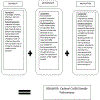Harnessing implementation science to optimize harm prevention in critically ill children: A pilot study of bedside nurse CLABSI bundle performance in the pediatric intensive care unit
- PMID: 32818579
- PMCID: PMC7889766
- DOI: 10.1016/j.ajic.2020.08.019
Harnessing implementation science to optimize harm prevention in critically ill children: A pilot study of bedside nurse CLABSI bundle performance in the pediatric intensive care unit
Abstract
Objective: Central-line associated bloodstream infection (CLABSI) is associated with increased mortality, morbidity, and cost in hospitalized children. An evidence-based bundle of care can decrease CLABSI, but bundle compliance is imperfect. We explored factors impacting bundle performance in the pediatric intensive care unit (PICU) by bedside nurses.
Methods: Single-center cross-sectional electronic survey of PICU bedside nurses in an academic tertiary care center; using the COM-B (capability, opportunity, motivation) and TDF (theoretical domains framework) behavioral models to explore CLABSI bundle performance and identify barriers to compliance.
Results: We analyzed 160 completed surveys from 226 nurses (71% response rate). CLABSI knowledge was strong (capability). However, challenges related to opportunity were identified: 71% reported that patient care requirements impact bundle completion; 32% described the bundle as stressful; and CLABSI was viewed as the most difficult of all bundles. Seventy-five percent reported being highly impacted by physician attitude toward the CLABSI bundle (motivation).
Conclusions: PICU nurses are knowledgeable and motivated to prevent CLABSI, but face challenges from competing clinical tasks, limited resources, and complex family interactions. Physician engagement was specifically noted to impact nurse motivation to complete the bundle. Interventions that address these challenges may improve bundle performance and prevent CLABSI in critically ill children.
Keywords: Bacteremia; Behavioral science; Central-line associated bloodstream infection; Hospital-acquired infection; Infection prevention.
Copyright © 2020 Association for Professionals in Infection Control and Epidemiology, Inc. Published by Elsevier Inc. All rights reserved.
Conflict of interest statement
Figures



Similar articles
-
Identifying high-risk central lines in critically ill children: A novel nurse-driven screening and mitigation intervention to reduce CLABSI.Am J Infect Control. 2025 Mar;53(3):381-386. doi: 10.1016/j.ajic.2024.10.029. Epub 2024 Nov 4. Am J Infect Control. 2025. PMID: 39505114
-
The impact of central line bundles on the timing of catheter-associated bloodstream infections and their microbiological distribution in critically ill children.Eur J Pediatr. 2023 Oct;182(10):4625-4632. doi: 10.1007/s00431-023-05141-7. Epub 2023 Aug 9. Eur J Pediatr. 2023. PMID: 37555974
-
Central line-associated blood stream infections in pediatric intensive care units: Longitudinal trends and compliance with bundle strategies.Am J Infect Control. 2015 May 1;43(5):489-93. doi: 10.1016/j.ajic.2015.01.006. Am J Infect Control. 2015. PMID: 25952048 Free PMC article.
-
Are central line bundles and ventilator bundles effective in critically ill neonates and children?Intensive Care Med. 2013 Aug;39(8):1352-8. doi: 10.1007/s00134-013-2927-7. Epub 2013 Apr 25. Intensive Care Med. 2013. PMID: 23615702 Review.
-
Digitalised measures for the prevention of central line-associated bloodstream infections: a scoping review.Antimicrob Resist Infect Control. 2025 May 12;14(1):45. doi: 10.1186/s13756-025-01549-y. Antimicrob Resist Infect Control. 2025. PMID: 40355970 Free PMC article.
Cited by
-
Identifying high-risk central lines in critically ill children: A novel nurse-driven screening and mitigation intervention to reduce CLABSI.Am J Infect Control. 2025 Mar;53(3):381-386. doi: 10.1016/j.ajic.2024.10.029. Epub 2024 Nov 4. Am J Infect Control. 2025. PMID: 39505114
-
Numbers and narratives: how qualitative methods can strengthen the science of paediatric antimicrobial stewardship.JAC Antimicrob Resist. 2022 Jan 22;4(1):dlab195. doi: 10.1093/jacamr/dlab195. eCollection 2022 Mar. JAC Antimicrob Resist. 2022. PMID: 35098126 Free PMC article. Review.
-
Formative Evaluation of CLABSI Adoption and Sustainment Interventions in a Pediatric Intensive Care Unit.Pediatr Qual Saf. 2024 Apr 3;9(2):e719. doi: 10.1097/pq9.0000000000000719. eCollection 2024 Mar-Apr. Pediatr Qual Saf. 2024. PMID: 38576891 Free PMC article.
-
Developing the Key Driver Diagram by Analyzing Home Central Line Caregiver Proficiency Factors.Pediatr Qual Saf. 2023 Mar 13;8(2):e638. doi: 10.1097/pq9.0000000000000638. eCollection 2023 Mar-Apr. Pediatr Qual Saf. 2023. PMID: 36926216 Free PMC article.
-
Initiation of interdisciplinary prevention rounds: decreasing CLABSIs in critically ill children.Antimicrob Steward Healthc Epidemiol. 2024 May 8;4(1):e80. doi: 10.1017/ash.2024.55. eCollection 2024. Antimicrob Steward Healthc Epidemiol. 2024. PMID: 38721488 Free PMC article.
References
-
- James JT. A new, evidence-based estimate of patient harms associated with hospital care. J Patient Saf. 2013; 9(3):122–128. - PubMed
-
- Lyren A, Brilli RJ, Zieker K, Marino M, Muething S, Sharek PJ. Children’s hospitals’ solutions for patient safety collaborative impact on hospital-acquired harm. Pediatrics. 2017; 140(3). - PubMed
-
- Ziegler MJ, Pellegrini DC, Safdar N. Attributable mortality of central-line associated bloodstream infection: systematic review and meta-analysis. Infection. 2015; 43: 29–36. - PubMed
-
- Miller MR, et al. Decreasing PICU Catheter-Associated Bloodstream Infections: NACHRI's Quality Transformation Efforts. Pediatrics. 2010; 125 (2): 206–213. - PubMed
Publication types
MeSH terms
Grants and funding
LinkOut - more resources
Full Text Sources
Other Literature Sources

